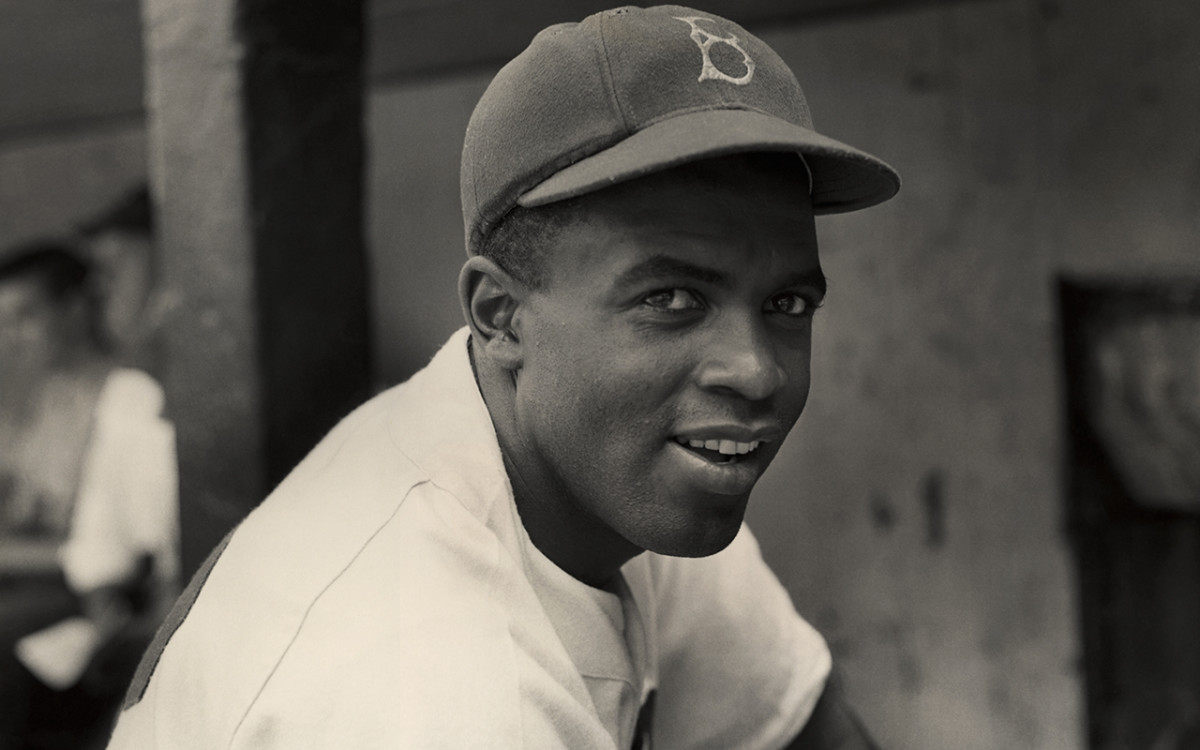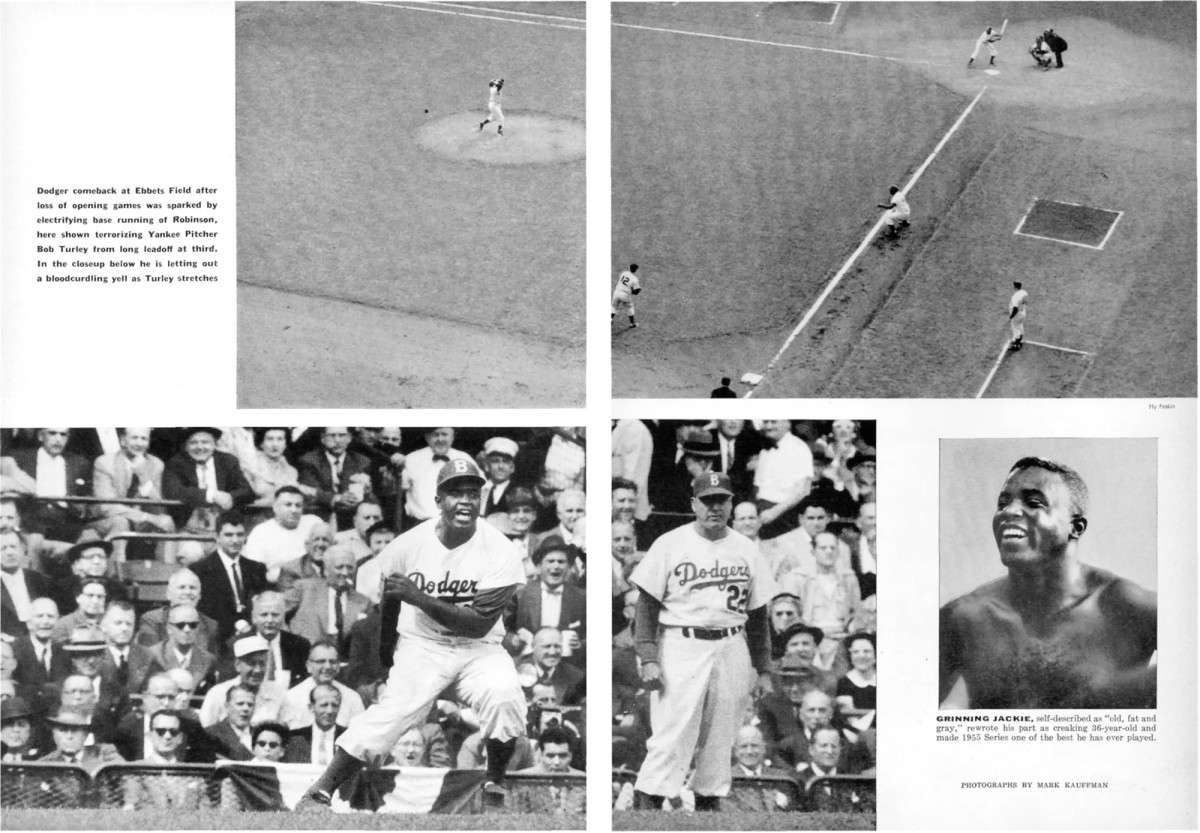Sports Illustrated's Best Jackie Robinson Stories
Seventy-two years ago, on April 14, 1947, Jackie Robinson changed baseball forever by debuting for the Brooklyn Dodgers. The momentous occasion is celebrated every year on what is now known as Jackie Robinson Day. Each major league player will don his No. 42 at some point this week as the sport celebrates one of its all-time icons.
Below is a list of SI's best work documenting the life and legacy of Jackie Robinson.
The Breakthrough
By William Nack
Published May 5, 1997
In the middle of the cool, drizzly afternoon of Sunday, May 25, 1947, as the Brooklyn Dodgers led the Philadelphia Phillies 4–3 in the eighth inning, Jackie Robinson ground his spikes into the rain-softened dirt of the batter's box at Ebbets Field, turned to face Phillies reliever Tommy Hughes and waited for Hughes's 3-and-1 cripple.
Forty days had passed since Robinson donned a Dodgers uniform and became the first black man in this century to play in the majors, going 0 for 3 in his debut at Ebbets on April 15. In recent games the 28-year-old rookie had begun to evince signs of settling down and playing the crisp, commanding brand of ball that Branch Rickey, the Dodgers' president, had predicted of him. "You haven't seen the real Robinson yet," Rickey had been telling writers all spring. "Just wait."
Keeper of the Flame
By Kostya Kennedy
Published April 16, 2012
Early this year in its airy, wood-floored main space in downtown Manhattan, the Jackie Robinson Foundation held a fund-raising event commemorating what would have been the Hall of Famer's 93rd birthday. The evening also honored former Yankees owner George Steinbrenner, who posthumously received the foundation's annual Chairman Award for having "carried on the tradition of Jackie Robinson." Although the Yankees were no friend to Robinson during his playing days with the Brooklyn Dodgers—the Yanks heckled him profoundly while beating Brooklyn in five of six World Series—Steinbrenner had, over a 37-year ownership reign, which began in 1973, been generous in charity and loyal to baseball people in need. The former Yankee Darryl Strawberry, an African-American slugger whose career was derailed by drug use, was on hand to express gratitude to the Boss for "sticking by me and pulling me up when no one else would."

Several ex-players attended the event, including Hall of Fame second baseman Joe Morgan, as well as foundation chair and former National League president Len Coleman. But the light in the room came from somewhere else: a woman in a black pantsuit, with shoulder-length gray hair and dangling earrings. She mingled unhurriedly, occasionally dispensing hugs to those she knew. Other guests kept looking toward her, angling to get close, to eavesdrop on her banter, to shake her hand, to take in her glow. She needed no name tag. This was Rachel Robinson, Jackie's widow. To observe her for any length of time and then to learn that she will soon turn 90 is akin to learning that yes, in fact, cows can fly. She looks 68.
A Home Run for the Ages
By Brad Herzog
Published April 1, 1996
Say what you will about the dramatic home runs hit by Babe Ruth, Bobby Thomson and Bill Mazeroski. Praise the thrilling shots hit by Carlton Fisk, Kirk Gibson and Joe Carter. But perhaps the most significant home run in baseball history was struck 50 years ago, on April 18, 1946, by Jackie Robinson, when he made his regular-season debut in organized baseball and served notice that he was the right man to break the sport's color barrier.
Six months earlier the International League's Montreal Royals, the Brooklyn Dodgers' top farm club, had called a press conference, promising an announcement that would affect baseball "from coast to coast." There was speculation that Ruth might be named the Royals manager or perhaps Montreal was going to get a big league franchise. Instead there was this stunning development: Dodgers president and general manager Branch Rickey had signed Jack Roosevelt Robinson, a 26-year-old shortstop with the Kansas City Monarchs of the Negro American League and assigned him to the Royals.

Recalling Jackie Robinson Through the Eyes of a Former Teammate
By Nicholas Dawidoff
Published September 28, 1987
When he first met Jackie Robinson, Carl Erskine was a 20-year-old minor leaguer pitching for the Brooklyn Dodgers' farm team in Fort Worth. "The Dodgers came through to play us just before Jack's sophomore season began, when he was still battling to be accepted," says Erskine. "I pitched three strong innings and afterward Jack took me aside and said, 'Young man, you aren't going to be in this league very long. You'll be with us by midseason.' I was. I joined the Dodgers in Pittsburgh and didn't know anybody. I walked into the clubhouse and set my bag down. The first man to talk to me was Jack Robinson. He said: 'I told you, young man, that you'd be here. Welcome.' From that moment, we had a special friendship."
Erskine is recalling all this while standing in the lobby of the New-York Historical Society. He has flown to Manhattan from his native Anderson, Ind., to see "Jackie Robinson: An American Journey," a multimedia exhibition celebrating baseball's first black major leaguer. The exhibit will tour the country during 1988, going to Los Angeles, Washington, D.C., Atlanta and Chicago. Erskine is now a bank president in Anderson, and something of a gentleman vegetable farmer. Three decades ago he struck out 14 Yankees in a World Series game—then a record—but because he had a chronically sore right arm, he generally tried to get batters to put the ball in play quickly. In 12 major league seasons, all with the Dodgers, Erskine won 122 games, including two no-hitters, one of them coming in 1956 against the Dodgers' bitterest rivals, the New York Giants. When a muscle tear in his pitching arm forced him to retire at age 32, Erskine moved his family back to Anderson, figuring it was a better place to raise his infant son, Jimmy, who was born with Down's syndrome.
And Then The Barrier Broke: Remembering Robinson's First Days in MLB
By Jay Jaffe
Published April 14, 2017
April 15: Boston Braves at Brooklyn Dodgers, Ebbets Field
The front page of the morning’s New York Times contained stories on U.S. Secretary of State George Marshall’s plan to keep Germany disarmed, Soviet Prime minister Joseph Stalin’s conversation with presidential candidate Harold Stassen, talks to end a week-long national strike of telephone workers, and news of a local smallpox outbreak. It did not, however, report that history was about to be made at Ebbets Field in Brooklyn. The only time baseball had broken through to the front page of the Gray Lady that month was on April 10, when commissioner Happy Chandler suspended Brooklyn Dodgers manger Leo Durocher for one year due for “the accumulation of unpleasant incidents detrimental to baseball.”
It was amid the fallout of that front page story that Dodgers president and general manager Branch Rickey chose to announce the purchase of Jackie Robinson’s contract from the Montreal Royals, on the heels of a spring training spent in Havana and the eve of what was effectively a dress rehearsal. From April 11-13, the Dodgers played a three-game exhibition series against the Yankees at Ebbets Field, during which Robinson drove in five runs and handled everything cleanly at first base, his new position. In the April 15 sports section, Times columnist Arthur Daley praised Rickey's timing of the promotion amid the Durocher-related chaos: "He practically smuggled him in… merely an attempt to lighten the pressure on Robinson's shoulders."

Robinson Was Safe
Published October 10, 1955
That vivid competitor, Jackie Robinson, got the World Series off to a steaming start by stealing home and instantly provoking a rhubarb: Was he really safe as Umpire Bill Summers called him—or out, as Yankee Catcher Yogi Berra burningly insisted (see inset cut)? Newspaper photographs, several taken from distorting angles, made him seem out. The two Associated Press pictures on the opposite page confirm the umpire's decision and settle the case. Meanwhile, the Yankees took a commanding lead by winning first two games, only to have Brooklyn come back to win the next three—a feat without precedent in the Series. But, back in their own park again, the Yankees evened matters with the help of Whitey Ford's masterful pitching, thereby forcing Series to full seven games.
Editor's Note: Earlier in the 1955 season, SI published a story about Jackie Robinson's new, semi-controversial way of running the bases.
What Jackie Robinson Means to Me
By Jimmy Rollins
Published: April 15, 2015
I always thought it was special to be a black player on the Dodgers. I was even a little envious of those guys, especially on Jackie Robinson Day. I used to think how awesome it was not only to wear his number 42 on your back but also his team’s name across your chest, and how that was something I would love to do one day. Being in Philadelphia for so long—14 full seasons—I didn’t think it would ever happen, but it will on April 15. Putting on Jackie’s uniform, in my first season with Los Angeles, will be a powerful moment for me.
The Dodgers and Branch Rickey had the courage to not only change baseball but also to help push America into the civil rights era, and Jackie had the courage to not fight back against all the abuse he took. Sometimes I ask myself, Could I have done that if I were in his shoes? I’m not sure. I do know that the sacrifices that he made are a significant part of the reason why all African-Americans, and Latin Americans too, can play the game today.
Timeline: Jackie Robinson Through the Years
One of the most iconic players in baseball history, Jackie Robinson was a Hall of Famer and a hero for his exploits on the field with the Dodgers and for breaking the game’s color barrier in 1947. In honor of one of the all-time greats, here’s a timeline of some of his greatest moments, plays and achievements.
